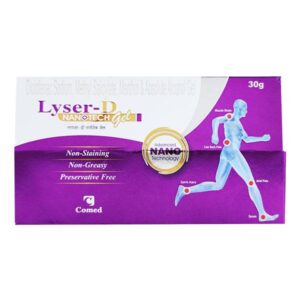DICLOFENAC + MENTHOL + METHYL SALICYLATE
Diclofenac: Diclofenac is a nonsteroidal anti-inflammatory drug (NSAID) that is commonly used to relieve pain, reduce inflammation, and treat various conditions such as osteoarthritis, rheumatoid arthritis, and ankylosing spondylitis.
The mechanism of action of diclofenac involves inhibiting the production of prostaglandins, which are chemicals responsible for pain, swelling, and inflammation in the body. By blocking the enzyme cyclooxygenase (COX), diclofenac reduces the production of prostaglandins, providing pain relief and reducing inflammation.
Diclofenac is available in various forms, including oral tablets, capsules, topical gel, ointment, and patches. The specific dose and dosing regimen may vary depending on the condition being treated and the formulation used. It is important to follow the instructions provided by the healthcare professional or the medication’s packaging.
As with any medication, diclofenac may have side effects. Common side effects include stomach discomfort, heartburn, nausea, and diarrhea. Some individuals may also experience dizziness, headache, and fluid retention. More serious but rare side effects may include gastrointestinal bleeding, liver and kidney problems, high blood pressure, and allergic reactions.
Diclofenac should not be used in certain situations, such as in patients with a history of allergic reactions to NSAIDs, peptic ulcers, severe heart failure, or during the third trimester of pregnancy.
It is essential to consult with a healthcare professional before starting diclofenac to ensure it is safe and appropriate for your specific needs. They can provide personalized dosing instructions and monitor for any potential complications or drug interactions.
Menthol: Menthol is a natural compound derived from the peppermint plant (Mentha piperita). It is commonly used as an ingredient in various products, including topical analgesics, cough drops, and oral hygiene products.
Menthol works by activating cold-sensitive receptors in the skin, producing a soothing and cooling sensation. This mechanism of action is thought to help relieve pain and itching. Additionally, menthol has mild local anesthetic properties that can temporarily numb the area of application.
Menthol is primarily used topically to relieve minor muscle and joint pain, as well as to alleviate the symptoms of common colds, coughs, and congestion. It is also found in various skincare products due to its cooling and soothing properties.
The dose of menthol varies depending on the specific product and formulation. For topical analgesics, the recommended dose is typically 1-2% menthol concentration in the product. It is crucial to follow the instructions provided by the manufacturer or consult a healthcare professional for precise dosage guidelines.
When used as directed, menthol is generally considered safe. However, some individuals may experience mild side effects such as skin irritation, redness, or tingling sensation at the application site. In rare cases, allergic reactions may occur, leading to more severe symptoms like rash, swelling, or difficulty breathing. If any of these side effects occur, it is important to discontinue use and seek medical attention.
It is worth noting that menthol should only be used externally and not ingested. Ingesting large amounts of menthol can cause adverse effects, including nausea, vomiting, dizziness, and potentially even organ damage. It is crucial to store menthol-containing products out of reach of children to prevent accidental ingestion.
As with any medication or supplement, it is advisable to consult a healthcare professional before using menthol, especially if you have any pre-existing medical conditions or are taking other medications. They can provide personalized advice and guidance based on your specific situation.
Methyl Salicylate: Methyl Salicylate is a drug that belongs to the class of nonsteroidal anti-inflammatory drugs (NSAIDs). It is commonly used as a topical analgesic and rubefacient to relieve minor muscle and joint pain. Methyl Salicylate is also found naturally in some plants, such as wintergreen oil.
The mechanism of action of Methyl Salicylate involves inhibiting the production of prostaglandins. Prostaglandins are chemical compounds that play a role in inflammation and pain sensation. By reducing their production, Methyl Salicylate helps to alleviate pain and reduce swelling.
Methyl Salicylate is typically available as a cream or liniment, and it is usually applied directly to the affected area. The recommended dose and frequency of application may vary depending on the product and the specific condition being treated. It is important to carefully follow the instructions provided by the healthcare professional or the product label.
While Methyl Salicylate is generally considered safe when used as directed, it may cause some side effects. Common side effects of Methyl Salicylate include mild skin irritation, such as redness or itching at the application site. In some cases, individuals may experience an allergic reaction, which can manifest as severe skin rash, swelling, or difficulty breathing. It is important to discontinue use and seek medical attention if any severe side effects occur.
Methyl Salicylate should not be used on broken or irritated skin, as it may further irritate the area. It should also be avoided in individuals who are allergic to salicylates or are taking blood-thinning medications, as it can interfere with blood clotting.
As with any medication, it is important to consult a healthcare professional before using Methyl Salicylate, especially if you have any pre-existing medical conditions or are taking other medications. They can provide personalized guidance on its use and help determine if it is appropriate for you.

